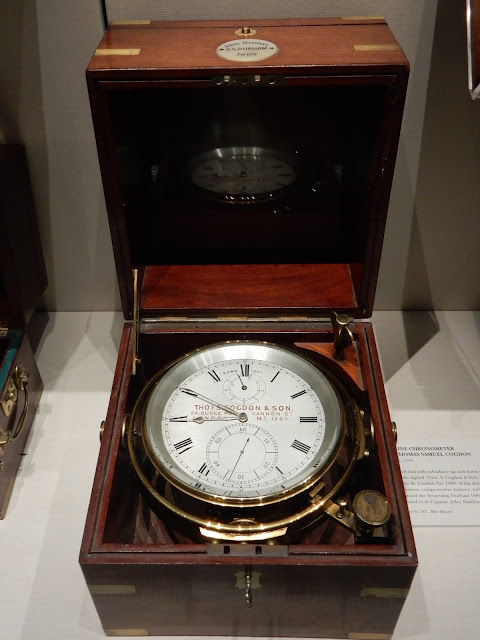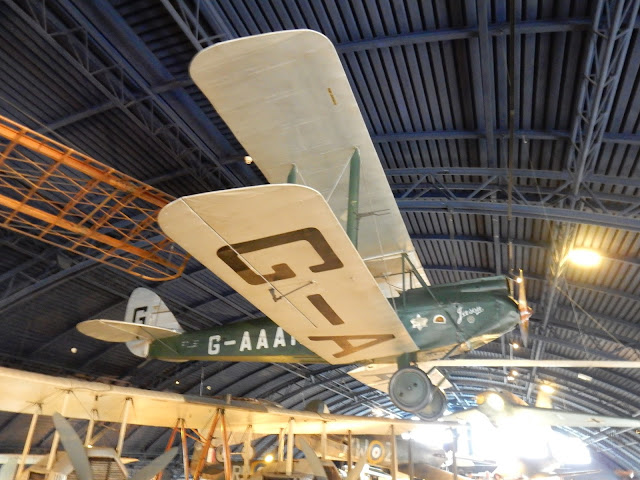Missed a few more blogs as I have popped back home for a couple of days. This blog is all about Friday last. We decided to go to the Science Museum as there were a few things we particularly wanted to see. We were meeting No.1 daughter there too.
Whilst we were waiting for her we looked round the collection of the Worshipful Company of Watch and Clock Makers housed there. This ship's chronometer brought back many memories for me as all ships had to have one and it was the 2nd Mates job to pay homage to it. As you may know it is a vital piece of equipment for position fixing in the days prior to GPS and satellite technology. Every day it had to be checked. The Radio Officer would tune in to a time signal and you would have to record the error along with the temerature. This was you could check any trends and see if it was developing a fault. The error would then be applied to all your calculations for better accuracy. It had to be would every so often too. On Merchant ships in the later years crews were minimal so where as you would have had a second person to record the actual times you took your sights we had to do it ourselves and once you brought the star or sun, planet of moons; reflection down to the horizon using the sextant to measure its altitude you would pace into the chart room whispering 'one elephant, two elephant etc' until you could read the chronometer, then take off the number of elephants and also apply the error to get the accurate time you took the sight.
The main thing we had come to see was this aeroplane called Jason. It is the DH60 Gypsy Moth aircraft that Amy Johnson made her record breaking flight to Australia in 1930. It is tiny. There has been some recent dispute between Hull and the Science Museum as the Museum would not release the aircraft to be brought to Hull for the Amy Johnson festival held her this year. It would mean closing the Museum for a long time to get it from the third floor but they do get £20 million from the public purse and it does feel a bit of a kick in the teeth for us Northerns just to be refused point blank.
Beneath Jason is the Vickers Vimy plane that was developed as a bomber for WWI. Alcock and Brown. A prize had been offered for the first flight from America or Canada to Britain or Ireland in under 72 hours. They took their aircraft over in pieces to St. John's Newfoundland. Once they had assembled they waited a while for a period of good weather and set off on 14th June 1919. No trials to see that they had put it together correctly or anything! just under 16 hours later the crossed over Ireland and decided to land. Unfortunately they chose a peat bog to land in and crashed. They still won the £10000 prize plus a £2100 each from a tobacco company and another £100 each from a citizen just for being British and doing it first. A few days later they were also knighted. Not bad for 16 hours work.
Just to give you a little idea of the scale of how small these planes were this poor photo shows the section through a Jumbo jet through the 'hump' at the front. There is the cargo bay at the bottom, then the 'cattle class' with the seat and overhead lockers with the First Class above.
We decided to walk up to Kensington Gardens to eat our lunch. As we passed through Kensington Gore and the Albert Hall we saw there was a cafe in the Hall so we resolved to go in for a coffee our our 'pack up'. It is called Gore not as there was a bloody battle here or an abattoir, but after the Gore Estate that was here before Albert made plans for a cultural zone in the area. In fact gore mean a narrow triangular piece of land.
I had never seen this massive memorial before as normally you only the Hall from the side nearest the Albert Memorial. This monument was designed as a memorial to the Great Exhibition of 1851. It was supposed to have Brittania on the top but as Prince Albert died in 1851 Queen Victoria had Albert place up there so this is also a mini Albert memorial. He is of bronze as the the seated figure that represent four continetnt. It was unveiled in 1863 in the Royal Gardens on the site. It was moved to this place in 1893. It was removed for major works to the Hall in 1998 and unveiled once more in 2001.
Whilst waiting for our coffee we saw that there were tours of the hall taking palce and one was just about to get underway. We had planned to attend a performance of the Proms but that was not going to happen so decided to go on the tour. This is the gallery I think it was called and would be where I would watch from if I didn't have a seat, rather than standing in the middle in front of the orchestra. The only sell between 300 and 500 tickets for this area, depending on what is the attraction. It seems that right round the balustrade will take 300 so even with 500 up here there would be room to sit down and move about rather than being crowded in.
Soon after the Hall was completed they found that their was a 6 second echo through the building largely due to the domed roof. This must have made listening to music very confusing indeed. They first tried to fix it by spreading canvas across the roof soon after it opened in 1871. It wasn't entirely successful and in 1949 it was removed and the fluted aluminium panels like a fan were installed. This didn't work properly either ant it wasn't until 1969 that problem was solved by a German Company installing these fibreglass 'flying saucers'. They work by absorbing some sound and also reflecting it back down into the Hall. So for nearly a hundred years this place was a terrible place to listen to music!
We were told not to take pictures of the concert area as there were musicians practicing but this picture shows the steepness of the seats and the height above the platform level.
We then walked through Hyde Park and found this curious building by the Serpentine gallery. It was a cafe and inside looked like an ice house, or one of those tunnels that run under a glazier. I different place to have a cup of tea and a bun.
Before we arrived at Park Lane we came across this monument erected to all the Cavalry Units of the Empire in WWI and later WWII. It was made from bronze guns captured in WWI and shows St George on his horse astride the slain dragon. on Portland stone with a bronze frieze around it. It was originaly placed by the Stanhope Gate to Hyde Park opposite the Dorchester in 1924. When Park Lane was widened in 1960 it was moved to this site within the park. It was remounted on a granite plinth and the wall that surrounded the statue with the bronze frieze and the list of the 150 cavalry units remembered was altered with the frieze on the plinth.
I loved this art deco work on the building that is now part of Aspery the jewelers. They bought this building in 1859 and it means they now have an entrance an entrance on New Bond Street and Albemarl Street. It used to be the Alfred Club. The club was founded in 1808 and had been limited to 600 members who each had to pay an annual subscription of 8 guineas and 8 guineas a visit.
It wasn't just rich and expensive shops we passed bu the Royal Institute too. It was founded in 1799 and got it's royal patent the next year. It has always been based at this building and it is dedicated to difusing knowledge and demonstrations of mechanical matters along with philosophical and experimental science.
There were still more expensive shops to pass as we saw the Burlington Arcade and passed through this one the Royal Arcade that connects Old Bond Street with Albermarle Street. It was just the 'Arcade' until the shirt maker H.W. Brettell won a Royal Patent from Queen Victoria. It was constructed in 1879.
We were heading to the Royal Academy to see the new David Hockney exhibition of portraits. It was founded in 1768 by King George III to promote British arts and designs. It moved Burlington House its current location in 1868 one hundred years later. It is unique in that it is run and funded by artists themselves although the Government own the building it is give to the RA rent free. the exhibition was good. All the portraits are on the same size canvas using the same setting and carried out roughly over a year in Los Angeles last year and the start of this year. He does seem to be able to grab something in his paintings and you feel that he does get 'meaning' into the faces without going on too much.
Whilst we were waiting for our time slot Helen couldn't resist popping over the road to Fortnum and Mason's. It was established here in 1707 and is still going strong selling luxury products. We came away with a tube of biscuits, because Helen liked the tin!!
















No comments:
Post a Comment